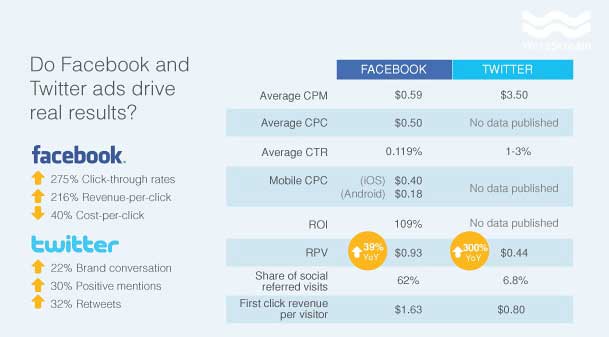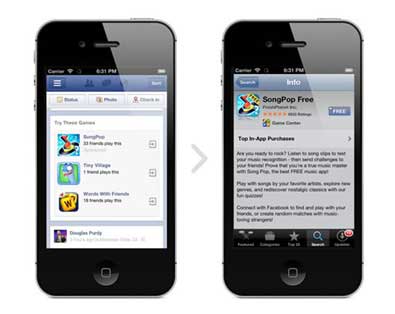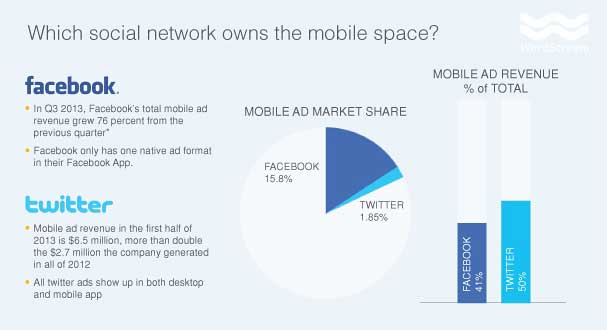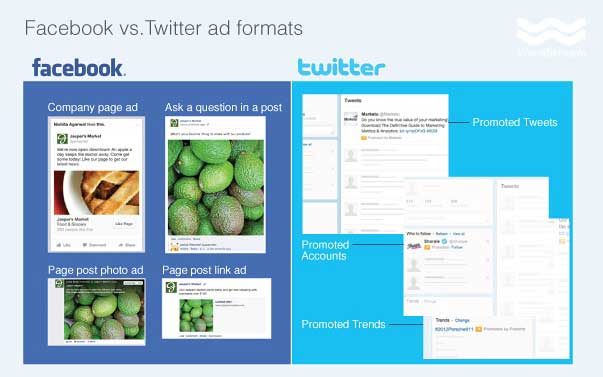In social advertising, where is your money better spent—on Twitter, or on Facebook?
Facebook allows for some useful targeting, with a variety of expressed and implied interests available as options for targeting its users, and it has worked hard to improve its ad platform since its IPO last year.
Still, although 85% of marketers polled at the beginning of 2013 by AdAge said they use Facebook as a marketing tactic, among them just 61.5% said they have used it for advertising. Facebook's Sponsored Stories ad product gets rave reviews from some, yet less than 30% have given it a shot.
Twitter, on the other hand, offers a variety of "Promoted" products—Tweets, Accounts, and Trends—and worked hard at improving its self-serve platform in the year prior to its broad rollout in April 2013. Yet, again, results are mixed, and it seems Twitter still has a ways to go as an advertising platform.
I recently did some research into Twitter and Facebook ads to see just how each measures up, comparing them in four categories:
- Network reach: Which platform reaches the largest audience?
- Ad performance: Do Facebook and Twitter ads drive real results?
- Mobile ad performance: Which social network owns the mobile space?
- Ad formats: Which offers the most varied and effective ad types?
What I found might surprise you. Although some are so passionately behind Facebook they'd have you believe it's the best thing since TV, the truth is actually that it's doing OK. Yes, I mean just OK; it's not going to save your business, but it doesn't seem a total waste, either, as Forrester might have you believe (its analyst's recent open letter to Mark Zuckerberg claims Facebook comes dead last on a satisfaction index of digital marketing channels).
There are areas in which Facebook is definitively beating out Twitter, such as Revenue per visitor. However, Twitter presents opportunities many aren't yet capitalizing on, simply because they haven't yet given it a chance.
Have a look at our key findings across four measurement categories.
1. Twitter vs. Facebook: Network Reach
Facebook trumps Twitter for network reach, with 1.15 billion active users to Twitter's 232 million. Although users share 500 million tweets a day, that pales in comparison with Facebook's 4.75 billion items posted daily.
For sheer network size and reach, we give Facebook and A+; meanwhile, Twitter has some homework to do, and it has room to improve.

Marketers are looking for that massive audience, which explains why Facebook takes 57% of social media advertising budgets while Twitter trails far behind with 13%.
2. Twitter vs. Facebook: Ad Performance
Actual ad performance is a tough metric to track, especially since the metrics the two networks release to the public differ. For example, we know the average CPC on Facebook is $0.50, but Twitter doesn't release that data.
There are things we do know, however:

AdWeek tells us that engagement rates (which includes favorites, re-tweets, replies, clicks, etc.) for Twitter ads can be as high as 1-3%, which is much higher than Facebook's average CTR of 0.119%. In this respect, Twitter has already mastered the issue that Facebook has been trying to correct with its in-stream Sponsored Stories ads; Promoted Tweets are, by nature, in-stream. Advertisers will notice a significantly higher CPM on Twitter, at $3.50, compared with just $0.59 on Facebook.
We can make an apples-to-apples comparison on revenue per visitor, which clearly goes to Facebook with $0.93 compared with $0.44 on Twitter. Of note, though, is that Twitter's RPV has grown exponentially year over year (YOY), with a 300% gain, while Facebook's RPV growth is much smaller at just 39%.
We also found that Facebook has lost ground in share of social referred visits, with a 20% decrease YOY, bringing it to 62%. However, that still beats out Twitter's paltry 6.8% share of social visits, though it's increased 258% this year.
Twitter touts its Promoted Trends product, reporting a 22% lift in brand conversion and 32% lift in retweets. They're pricey, though, and this is not a product for SMBs; at up to $200,000 a day or more, Promoted Trends are a big brand advertising tool.
Facebook Ads, on the other hand, are still hit and miss with performance largely affected by vertical. The average CPC for alcohol brands, for example, is 45% higher than the average across verticals (PDF), while gaming brands enjoy a 40% lower CPC.
Overall, AdAge ranks Google the most important advertising platform in terms of ROI, followed by Facebook and then Twitter. I tend to agree, as Twitter still has much to prove—especially now as a public company.
3, Twitter vs. Facebook: Mobile Ad Performance
Twitter has an inherent mobile advantage, because Promoted Tweets are in-stream and therefore look and feel natural for mobile users. Facebook Ads in the right rail don't even exist on mobile apps, which is a huge missed opportunity for advertisers.

Whereas Facebook has just one native ad format in its app (the App Promotion Ad), Twitter ads show up both on desktop and mobile. In this regard, we see a distinct advantage for Twitter. So it must own the mobile ad space, right? Not even close:

Facebook is blowing Twitter away in mobile ad market share, but watch for a shake-up in 2014. Analysts expect Twitter to net $1.33 billion in worldwide ad revenue by 2015, with more than 60% of that coming from mobile ads.
The edge here goes to Facebook today, though it's in a perfect position to be toppled.
4. Twitter vs. Facebook: Ad Formats
Facebook has had to work hard at simplifying its ad offerings for marketers, and it announced big changes in June 2013, when it promised to cut the number of ad formats by more than half by the end of the year.

Facebook's ad formats now include the following:
- App ads
- Domain ads
- Mobile app ads
- Offer ads
- Page-like ads
- Page post link ads
- Page post photo ads
- Page post text ads
- Page post video ads
- Sponsored stories
Some analysts tend to be forgiving and they applaud Facebook's "simplification," though I tend to see it as an admission by Facebook that more than half of its ad formats simply didn't work.
Ad formats on Twitter have always been simpler; it offers just three products: Promoted Tweets, Promoted Accounts, and Promoted Trends.
I expect Twitter will roll out new ad formats in 2014, though if it stays true to form, there will be an extensive period of limited beta testing prior to any release.
Conclusion: No Big Winners Here
When considering tracking, analytics, and measurement, marketers are thirsty for more across both platforms. Brands still struggle with multitouch attribution and with placing an accurate dollar value on each social interaction, whether organic or ad-induced.
In summary, I can't in good conscience recommend either Twitter or Facebook advertising as a good direct response (lead generation) marketing tactic. The intent just isn't there compared with search.
Facebook and Twitter are great for brand awareness, content marketing, and other soft sales tactics. Use them to build relationships, educate consumers, and engage fans—if you have budget for these types of activities. Both have a lot of work to do to prove their value to advertisers.
Advertisers should go into social advertising on Facebook and Twitter with clear goals, an open mind, and a willingness to pull the cord if it's just not working out.




